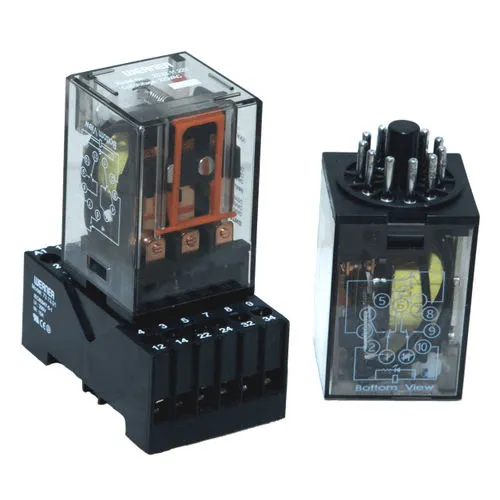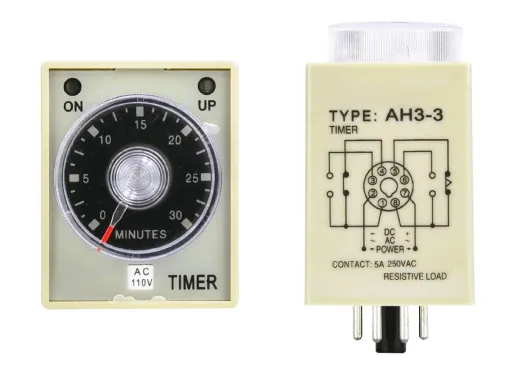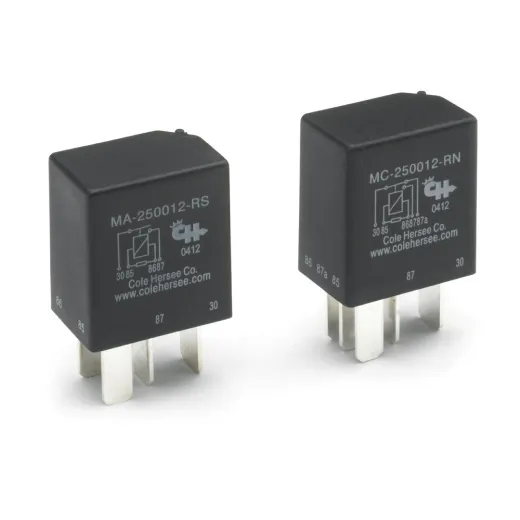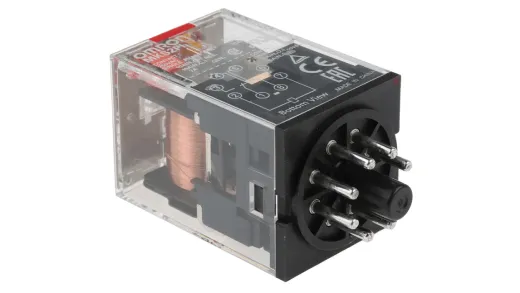Automotive Relays: Types, Advantages & Applications
Automotive relays are crucial parts of contemporary automobiles. By opening and closing contacts in other circuits, they function as a switch to regulate an electrical circuit. Relays regulate a higher current by using a smaller current. helps a variety of electrical systems so that cars can run securely and effectively.
Types of Automotive Relays
Electromechanical Relays
An electromechanical relay is a type of conventional relay that, in response to an electrical signal, employs mechanical connections to open or close the circuit. To build or detach, it is made up of an electromagnet that moves a number of contacts. In automotive applications, these relays have a reputation for being dependable and long-lasting. Switching high current circuits like cooling fans, lamps, and starters is a popular use for them. Applications that demand a high switching capacity and dependable handling of substantial electrical loads are better suited for electromechanical relays.

Time Delay Relays
A time delay relay is a unique type of relay that, in response to a control signal, delays shutting or opening the circuit. It is utilized in automobile applications where time is crucial, like headlight or interior illumination delay circuits. and in a delay start circuit to avoid simultaneous large current draw.

Micro Relays
Micro relays are compact versions of electromechanical relays, designed to save space in modern vehicles where real estate is limited. Despite their small size, they offer comparable performance to larger relays and are used in various automotive applications where size and weight reduction are priorities. Common uses include power window controls, door locks, and signal switching in vehicle electronics.

Power Relays
High current loads are intended for use with power relays. For operations that call for the distribution and operation of substantial volumes of electrical energy, this makes it perfect. Automotive technologies like power steering, electric cooling fans, and electrically heated seats all make use of these relays. This ensures that electrical factors will operate dependably and be defended when subordinated to high loads. It is a crucial component of contemporary vehicle design due to its sturdy structure and capacity to manage high electric current levels.

Advantages of Automotive Relays
High Current Capacity
Relays for cars are made to withstand large currents. This is significantly more than the capabilities of a typical electrical switch. The relay can now manage power-hungry parts like heaters, motors, and heaters thanks to this capability. and shoot safely without having to worry about overheating or losing electricity. with effective handling of high current Thus, relays ensure that the electrical system of the car runs long and efficiently. This enhances general dependability and security.
Benefits:
- Safety: Aids in preventing overheating and damage while ensuring the safe operation of high-current equipment.
- Durability: lessens the strain on the switching mechanism, extending the life of electrical equipment.
- Efficiency: Permits effective energy distribution with minimal loss. keeping the car system running at maximum efficiency.
Isolation
Electrical isolation between control and load circuits is provided by relays. Electrical disruptions or anomalies in the load circuit cannot impact the control circuit due to this isolation, and vice versa. Additionally, it lessens electromagnetic interference (EMI) and shields delicate electronic parts including sensors and vehicle control modules. It guards against surges or spikes in voltage brought on by other electrical components in the car.
Benefits:
- Protection: Avoid allowing interference or power outages to harm delicate electrical equipment.
- Reliability: Ensures consistent performance of control circuits by preventing interference from load circuits.
- Compliance: Helps meet regulatory standards for electromagnetic compatibility (EMC), essential for vehicle safety and reliability.
Compact Size
Modern automotive relays are engineered to be compact and lightweight, occupying minimal space within increasingly crowded vehicle compartments. Their reduced size allows for flexible installation in tight areas, optimizing design flexibility and integration into complex automotive systems without compromising functionality or performance.
Benefits:
- Space Saving: Facilitates efficient use of vehicle interior space, critical in compact or electric vehicles.
- Weight Reduction: Contributes to overall vehicle weight reduction, enhancing fuel efficiency and performance.
- Design Flexibility: Enables innovative vehicle designs and configurations without sacrificing relay performance or capability.
Versatility
Automotive relays are adaptable corridor that can be used in a variety of electrical system operations in buses . They can control a wide range of factors, including lights, motors, solenoids, and heating rudiments, since they can switch between resistive, inductive, and capacitive loads. Because of its adaptability, the relay can successfully satisfy the distinct operational needs of a range of automotive systems.
Benefits:
- Adaptability: Supports diverse applications within the vehicle, from simple lighting circuits to complex engine management systems.
- Enhanced Functionality: Enables integration of advanced features and functionalities into modern vehicles.
- Cost Efficiency: Reduces the need for specialized switches or controls by offering a single solution for multiple applications.
Applications of Automotive Relays
Lighting Systems
Relays for automobiles are crucial to the management of lighting systems. It serves as a switch to control the flow of power to the interior lights, fog lights, headlights, and taillights. These lighting components demand high currents, which are handled by relays. This keeps the wiring harness of the car from overheating and guarantees effective operation.
Examples:
- Headlights: To switch the high current needed for headlights, relays are utilized. They provide reliable functioning and boost brightness.
- Fog Lights: Permits the independent activation of fog lights and the main lighting system. enhances visibility when there is bad weather.
- Interior Lighting: The circuit for interior illumination is managed by the relay. For ease and security, roof lights and instrument panel lighting are included.
Heating and Cooling Systems
Relays control the operation of parts in vehicle heating and cooling systems, including electric heaters, air conditioner compressors, and radiator fans. The Relay therefore ensures efficient temperature management in the engine and passenger compartments by managing these components. It raises engine efficiency and comfort levels.
Examples:
- Radiator Fans: To avoid overheating while operating, the relay turns on and off the radiator fan based on the engine temperature.
- Air Conditioning Compressors: To maximize fuel efficiency and regulate cabin temperature, turn the compressor on and off.
- Electric Heaters: The electric heater that warms the seats or defrosts the windows is managed by the relay. In chilly conditions, it helps to improve driver comfort.
Engine Management
An essential component of the engine management system is the relay. It regulates crucial parts like the gasoline pump. The Relay ensures engine performance, fuel efficiency, and maximum vehicle reliability under various driving situations by controlling these functions.
Examples:
- Fuel Pump: When the engine begins, the relay turns on the fuel pump and keeps the fuel pressure constant while the engine is running. This guarantees that the engine will always have gasoline.
- Ignition System: Regulates the ignition module or coil. This makes it possible to time spark plug ignition precisely for effective combustion.
- Engine Cooling Fans: In order to maintain the right engine temperature, the relay turns on and off the engine cooling fan as needed. keeps components from being damaged and overheated.
Power Windows and Door Locks
Automotive relays are frequently employed to control the operation of motors that raise and lower windows in power window and door lock systems. Including turning the door lock and key. The large currents that these motors demand are controlled by relays. Convenience features and dependable and rapid car access control are offered by them.
Examples:
- Power Windows: Relays activate the window motors to raise and lower windows with a simple push of a button, offering convenience and ease of operation.
- Door Locks: They control the door lock actuators, allowing centralized locking and unlocking of vehicle doors from the driver's position or via remote keyless entry systems.
Fuel Systems
Relays play a critical role in vehicle fuel systems. It regulates how the gasoline pump, fuel injectors, and other parts that feed fuel to the engine work. The Relay controls these processes to ensure effective fuel delivery and combustion, enhance engine performance, and maximize fuel efficiency.
Examples:
- Fuel Injectors: The fuel injector's opening and closing are controlled by the relay. It provides each cylinder with the exact amount of gasoline required by the engine for maximum combustion.
- Fuel Pump: Maintains fuel pressure while operating the engine and initiates the fuel pump. This guarantees a steady fuel delivery to the engine in a variety of driving scenarios.
Safety and Security Systems
Relays are crucial components in car safety and security systems because they regulate actions like airbag activation. Relays for the warning system and anti-lock braking system (ABS) contribute to the prompt and dependable activation of these vital safety elements. This improves theft prevention and tenant protection.
Examples:
- Airbag System: Airbags are triggered by relays in the case of an accident. They swiftly inflate the airbag to shield the occupants from harm.
- ABS System: Regulates the ABS solenoid valve, which modifies the brake pressure when using emergency brakes. keeps steering control and avoids wheel lock-up.
- Alarm System: When there's an attempted theft or intrusion, the relay triggers the car's alarm system. to warn the owner and discourage would-be robbers.
Related Articles
How to Test Automotive Relays (Guide)
Applications of Circuit Protection: Everything Explained
Isolator vs Circuit Breaker: What's the Differences?
What Is Circuit Protection And Why Is It Important? (Guide)
LM386 Audio Amplifier Circuit: Features, Applications and Datasheet
Watt Amplifier Circuit:Types,Principle and Applications
Phototransistor : Circuit Pinout & Principle
Simple Electronic Circuits for Beginners
Varistors: How Do They Safeguard Circuits?
Isolator vs Switch Disconnector: What's the Main Differences?
Load Break Switch : Principle and Its Applications










